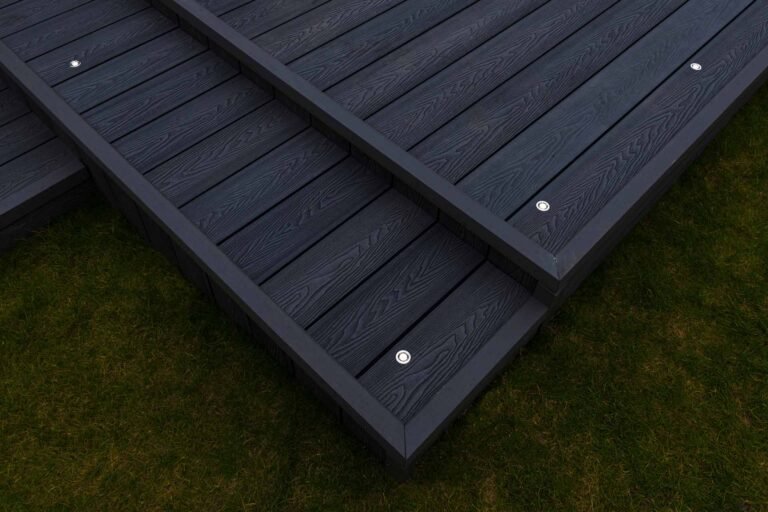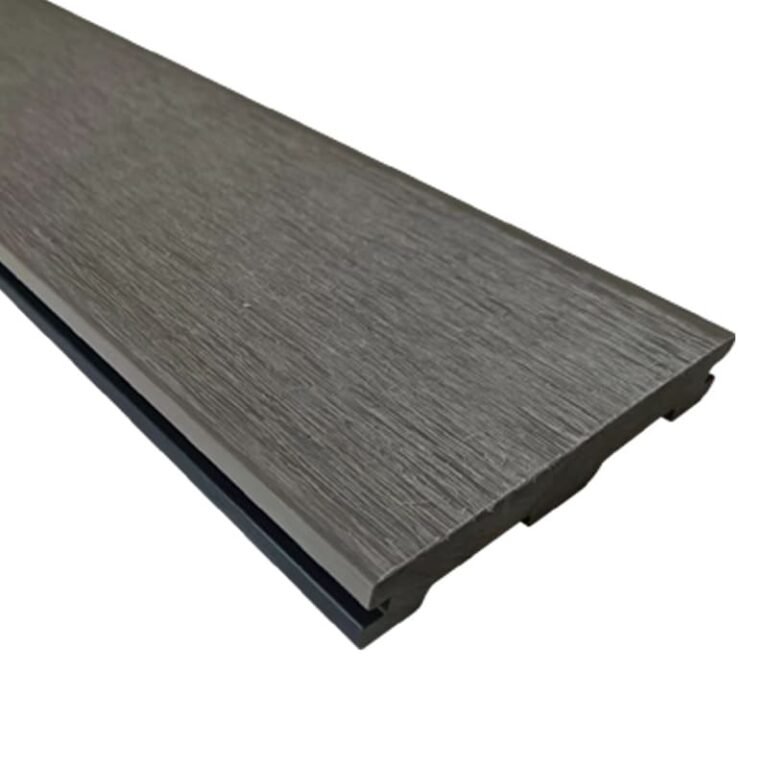Worried your customers' beautiful new decks will be too hot to use? A scorching surface can ruin a summer day. The right material choice is the key to comfort.
Yes, composite decking can get hotter than traditional wood, especially dark-colored boards under direct sunlight. Composites contain plastic, which absorbs and retains more heat than natural wood. However, selecting lighter colors and newer materials with cooling technology can significantly minimize this effect.
As someone who has been in the WPC industry for over 12 years, this is one of the most common questions my partners ask. They want to provide the best products for their customers, and that means being honest about performance. Composite decking has amazing benefits—low maintenance, long life, and great looks. But heat absorption is a real factor to consider, especially for importers in sunny climates. The good news is that this is a manageable issue. It all comes down to making informed choices about color, material, and even installation. I want to walk you through the specifics so you can guide your customers to a deck they will love and use, even on the hottest days. Let's dig deeper into what makes a deck hot and how to keep it cool.
Does composite decking get hot underfoot?
Your clients want a deck for relaxing, not for hopping on hot surfaces. A burning deck can be a real safety risk, especially for families with children or pets.
Yes, composite decking can become very hot to the touch, especially darker shades like charcoal or chocolate brown. On a bright, sunny day, these surfaces can be uncomfortable to walk on barefoot. Lighter colors like tan, light grey, or beige stay significantly cooler underfoot.
Over my years of working with distributors worldwide, I've seen this issue come up firsthand. I remember a partner in Australia who initially stocked a very popular dark grey decking. The feedback was great in terms of style, but during their peak summer, customer complaints about surface heat started rolling in. The beautiful decks were becoming unusable in the afternoon sun. We worked together to introduce a sand-colored and light grey option into his product line. The change was immediate. His sales of the lighter colors quickly overtook the darker ones, and the complaints stopped. This experience taught me a valuable lesson: color isn't just an aesthetic choice; it's a functional one. The heat you feel is directly related to the material's composition and color.
Breaking Down Surface Heat
To help your customers understand, it helps to know why this happens.
- Material Composition: Standard composite decking is a mix of wood fibers and plastic polymers. Plastic absorbs and holds onto heat more than natural wood, which is a better insulator.
- Color's Role: Dark surfaces absorb more of the sun's light energy and convert it into heat. Light surfaces reflect more light, keeping them cooler.
Here’s a simple comparison I use to explain it to my partners:
| Decking Type | Typical Heat Level Under Direct Sun | Barefoot Comfort |
|---|---|---|
| Dark-Colored Composite | Very High | Often uncomfortable/hot |
| Light-Colored Composite | Moderate | Generally comfortable |
| Pressure-Treated Wood | Moderate to Low | Usually comfortable |
| Exotic Hardwood (like Ipe) | High | Can get warm to hot |
This table helps put the issue into perspective. While composites can get hot, choosing a lighter color brings its performance right in line with, or even cooler than, some popular wood options.
How to stop composite decking from getting hot?
You've helped a client install a beautiful deck, but the heat is unbearable. They are looking for solutions, and you need to provide reliable answers for them.
The most effective way to prevent a composite deck from getting hot is to choose a light-colored, heat-reflective board from the beginning. If the deck is already built, adding shade with sails, pergolas, or umbrellas is the best solution to reduce surface temperature.
You can approach this problem in two ways: proactive choices made before installation and reactive solutions used after the fact. I always advise my partners to focus on the proactive stage with their customers, as it's the most permanent and effective way to manage heat. Setting expectations correctly from the start builds trust and leads to happier clients. A customer who understands that a dark brown deck in full sun will get hot is much better prepared than one who is surprised by it. Educating them on their options before they buy is the hallmark of a great distributor. It shows you're not just selling a product; you're providing a complete solution for their outdoor living space.
Proactive vs. Reactive Heat Management
Thinking ahead is always the best strategy. Here are the key points to discuss with clients.
1. Proactive Choices (Before Installation)
- Color Selection is King: This is the most important decision. Show samples of light vs. dark colors and, if possible, leave them out in the sun for an hour. The difference they feel will be more convincing than any words. Whites, beiges, and light greys are excellent choices.
- Consider "Cool Deck" Technology: Some manufacturers, including my team at Veejoy, are developing capstocks with special pigments that reflect more infrared light[^1]. While they still warm up, the temperature difference can be noticeable. Ask your supplier about these innovative options.
- Ensure Proper Ventilation: A deck built low to the ground with no airflow underneath can trap heat. Following proper installation guidelines with adequate gapping and under-deck ventilation allows heat to dissipate more effectively.
2. Reactive Solutions (After Installation)
- Create Shade: This is the best after-the-fact solution. Pergolas, retractable awnings, shade sails, or even large patio umbrellas can block the direct sun and dramatically cool the surface below.
- Use Outdoor Rugs: Placing light-colored outdoor rugs in high-traffic areas or seating zones provides a physical barrier and a cooler surface to walk on.
- Add Water: A quick spray with a garden hose can provide immediate, temporary relief by cooling the boards through evaporation. This is a great trick just before guests arrive for a barbecue.
How to make a composite decking cooler?
The summer sun is at its peak, and the deck has become a no-go zone. Your customers need practical ways to cool it down fast to enjoy their investment.
The fastest way to cool a hot composite deck is to rinse it with water. For a more lasting effect, add permanent shade with a pergola or use large, light-colored outdoor rugs[^2] in key areas to create cooler zones for walking and relaxing.
This question shifts the focus from prevention to active intervention. A client who is asking this is likely already dealing with a hot deck. My advice to distributors is to have a set of "cooling strategies" ready. This adds value beyond the sale and positions you as a helpful expert. One of our partners in the southern United States started offering bundled packages that included decking materials and options for shade sails. This was a brilliant move. It directly addressed the heat concern, provided a complete solution, and created a new revenue stream for his business. It showed his customers that he understood their environment and was proactive in helping them enjoy their outdoor space to the fullest.
Effective Cooling Methods Compared
Here’s a breakdown of methods you can suggest, comparing their effectiveness and effort.
| Cooling Method | Effectiveness | Cost & Effort | Best For |
|---|---|---|---|
| Rinsing with Water | High (Instant but Temporary) | Low Cost, Low Effort (Requires a hose) | Quick relief before using the deck for an event. |
| Adding Outdoor Rugs | Moderate (Creates Cool Zones) | Moderate Cost, Low Effort | Defining seating areas and creating cool pathways. |
| Using Shade Structures | High (Permanent and Consistent) | High Cost, High Effort (for pergolas/awnings) | Long-term, all-day cooling for the most-used parts of the deck. |
| Strategic Landscaping | High (Natural and beautiful) | Moderate Cost, High Initial Effort (Planting trees) | A long-term, eco-friendly solution that grows over time. |
I always recommend a layered approach. A large shade sail might cover the main seating area, while a few well-placed plants and an outdoor rug can handle other spots. Using water is a great trick for immediate use. By offering a range of solutions, you empower your customers to reclaim their deck from the summer heat.
What is the coolest composite deck material?
Your customers are getting specific. They want to know exactly what to buy to get the coolest possible deck. You need to guide them to the right product.
The coolest composite decking materials are always the lightest in color. Boards in shades of white, off-white, tan, or very light grey will absorb the least heat. Additionally, some high-end capped composites feature special cooling technology[^3] in their protective layer for enhanced performance.
When a customer asks this, they are ready to make a purchasing decision based on performance, not just looks. This is a great opportunity to demonstrate your deep product knowledge. In my manufacturing experience, we have tested countless variations of colors and polymer caps. The results are always crystal clear: color is the number one factor in surface temperature. A white or beige board can be up to 15-20°C (30-35°F) cooler than a black or dark brown board made from the exact same composite core material under the same sun. It's a massive difference. While advanced technologies help, nothing beats the basic physics of light reflection.
Key Factors for the Coolest Deck
To guide your customers to the coolest possible choice, focus on these three elements.
1. Color and Reflectivity
This is the most critical factor. Advise your customers to steer clear of dark browns, deep greys, and blacks if their deck gets a lot of direct sun.
- Excellent Choices: White, Beige, Light Tan, Light Grey
- Good Choices: Medium Grey, Lighter Brown Tones
- Poor Choices (for full sun): Charcoal Grey, Dark Brown, Black
2. Material Technology
The type of plastic and the additives in the capstock matter.
- Capped Composite: The protective polymer shell on capped composites can be engineered. We are seeing more "cool pigments" that reflect infrared radiation (heat) while still showing a rich color. Always ask your supplier if their lighter colors incorporate this technology.
- PVC Decking: Decking made purely from PVC (without wood fibers) can sometimes run a little cooler than WPC, especially in lighter colors. However, it often comes with a higher price tag.
3. Surface Finish
A glossy finish can sometimes reflect more light than a deeply embossed, matte finish. However, this effect is minor compared to the impact of the board's base color. The priority should always be choosing a light color first.
By focusing on these points, you can confidently recommend the coolest possible decking options, ensuring your customers get a product that performs well in their specific environment.
Conclusion
Ultimately, composite decking can get hot, but it is manageable. Choosing light colors and considering shade are the most effective strategies for a comfortable, usable, and beautiful outdoor space.
[^1]: Learn about the effects of infrared light on decking materials and how to choose the best options.
[^2]: Discover how outdoor rugs can create cooler zones on your deck, enhancing comfort for your guests.
[^3]: Discover innovative cooling technologies that can enhance the performance of composite decking in hot weather.









